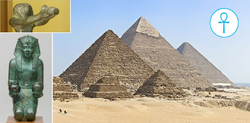- Retour accueil
- Vous êtes ici : Blog The Pyramids of the Cold The Pyramids of the Cold Section 7 • Inclined Well : The Bes Wedging Block
The Pyramids of the Cold Section 7 • Inclined Well : The Bes Wedging Block
Publié par Bruno Coursol dans The Pyramids of the Cold le 12/04/2022 à 20:11
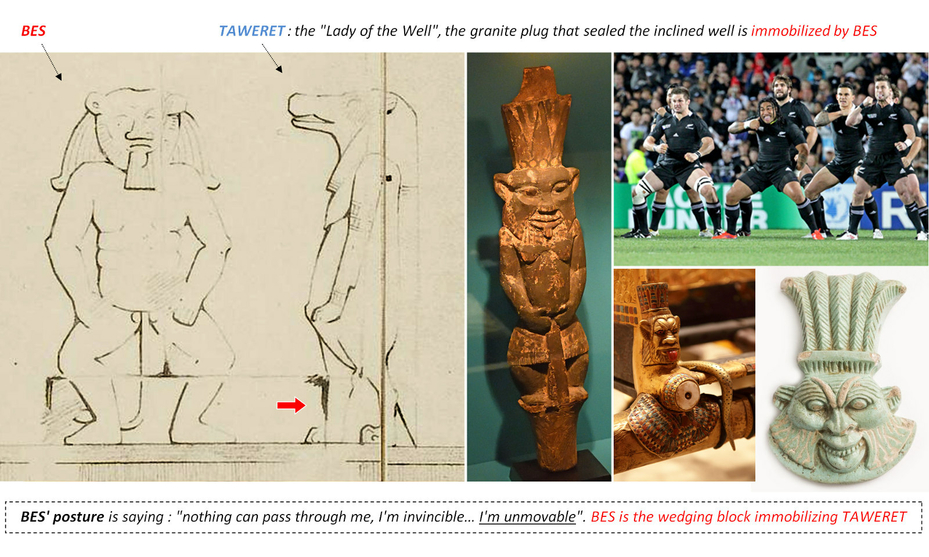
The Pyramids of the Cold - Section 7 • The Inclined Well : the Bes Wedging Block
In summary : the household protector Bes deity is a metaphoric representation of the wedging block of the inclined well of the Great Pyramid of Giza. This block maintained the Lady of the Well Taweret granite block in place during the entire operation period of the pyramid. For the shutdown procedure and the draining of the waters of the well, the protruding and fragile upper part of the block had been broken off by increasing the height of water and the pressure upon this block.
Also, the Māori ceremonial dance Haka performed by rugby players is referring to Bes : they are replicating his posture, his tongue out gesture and his knife cutting gesture. What Haka performers are saying to their adversaries is : "you'll not pass through me".
7.01 Bes : the wedging block that was immobilizing the Taweret block
This post is the continuation of the Taweret post and will focus on the wedging block that immobilized the Taweret block "the Lady of the Well", the granite plug #3 that was sealing the inclined well.
That wedging block was represented and deified into Bes, the dwarf deity.
"Bes (also spelled as Bisu), together with his feminine counterpart Beset, is an ancient Egyptian deity worshipped as a protector of households and, in particular, of mothers, children, and childbirth. Bes later came to be regarded as the defender of everything good and the enemy of all that is bad." https://en.wikipedia.org/wiki/Bes
The fact that both Bes and Taweret, as the wedging block and the sealing of the well block, were both associated with the draining of the well, explains why both were associated with childbirth : the metaphor is about the water breaking.
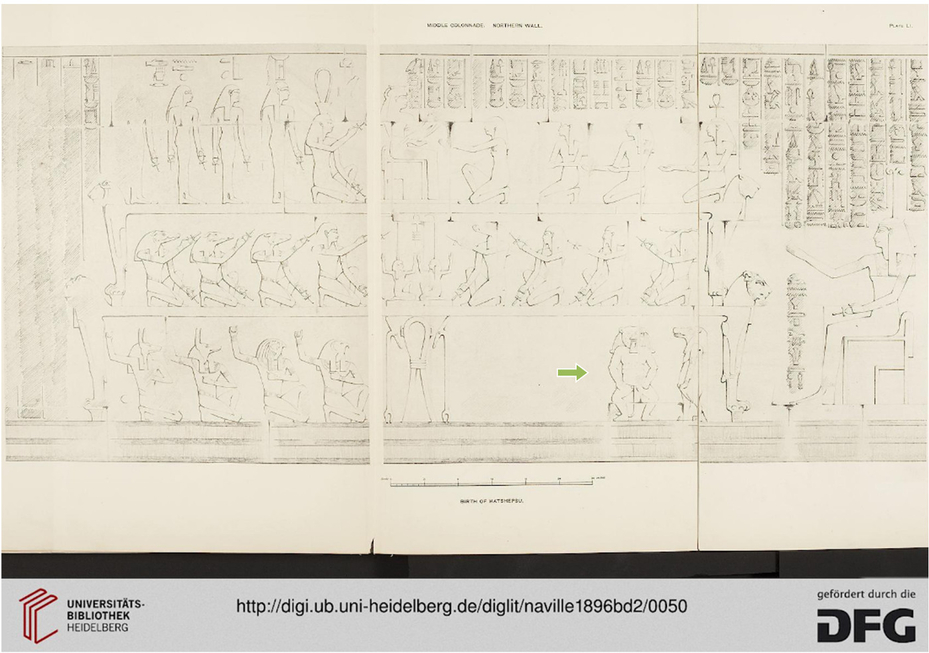
Hatshepsut’s birth scene, from Édouard Naville "The Temple of Deir el Bahari" (London, 1896), vol. 2, pl. 50. Image courtesy of the University Library Heidelberg : The Ebony shrine, northern half of the middle platform. https://digi.ub.uni-heidelberg.de/diglit/naville1896bd2/0050
7.02 The Hatshepsut’s birth scene, from Édouard Naville "The Temple of Deir el Bahari"
I really didn't expect to find any kind of proof that would validate the fact that the Taweret block was maintained in its position for the time being of the operating of the Great Pyramid, by a wedging block , but not only the immobilized Taweret/Bes scene is that proof and Bes that particular wedging block, but also we have to note the position of that scene within the entire relief : it is located at the very end of the story.
Whatever the story is exactly, the scene showing that Taweret was blocked by Bes is at the very end of it.
We can imagine 2 different approaches :
1 • Time related approach : the story ends up when it is time for Bes to break and stop immobilizing Taweret. It would be the end of the operating period of the pyramid.
2 • Space related approach : this is a plan of the entire ascending passage that starts with the Grand Gallery and the 4 crewmembers of one hauling beetle, and end with the Taweret/Bes couple at the bottom of the flooded part of the first ascending passage : the inclined well.
Between the 4 crewmembers and the Taweret/Bes couple, there is a bizarre empty space, but again it can be interpreted with both approaches : time and space related.
7.03 Bes is always depicted facing forwards to show he will not be moved
Bes depicted facing forwards is the main characteristic to understand about him.
In the previous post about Taweret, I suggested the idea that the bottom of the inclined well was sealed by the granite plug that is today at the beginning of the ascending passage and that this block (plug #3) was set higher in the passage : the ascending passage was not completely flooded.
That granite plug #3 has been deified into goddess Taweret, that had been called "the Lady of the Well" by ancient Egyptians themselves. I also suggested that, during the operational period of the well, that Taweret granite plug was maintained in its position by a wedging block that would have been set in the floor of the well, between the G8 and G9 girdles.
Bes is that wedging block.
This Bes block was designed to fight the pressure of the water of the well. It was designed to immobilize the Taweret block.
This is why Bes is depicted facing forwards. Bes' posture is saying : I'm invincible, I'm unmovable. Nothing will pass through me.
On the Hatshepsut’s birth scene, the rectangular block that is immobilizing Taweret, is purely metaphorical : that is actually Bes himself that is blocking her.
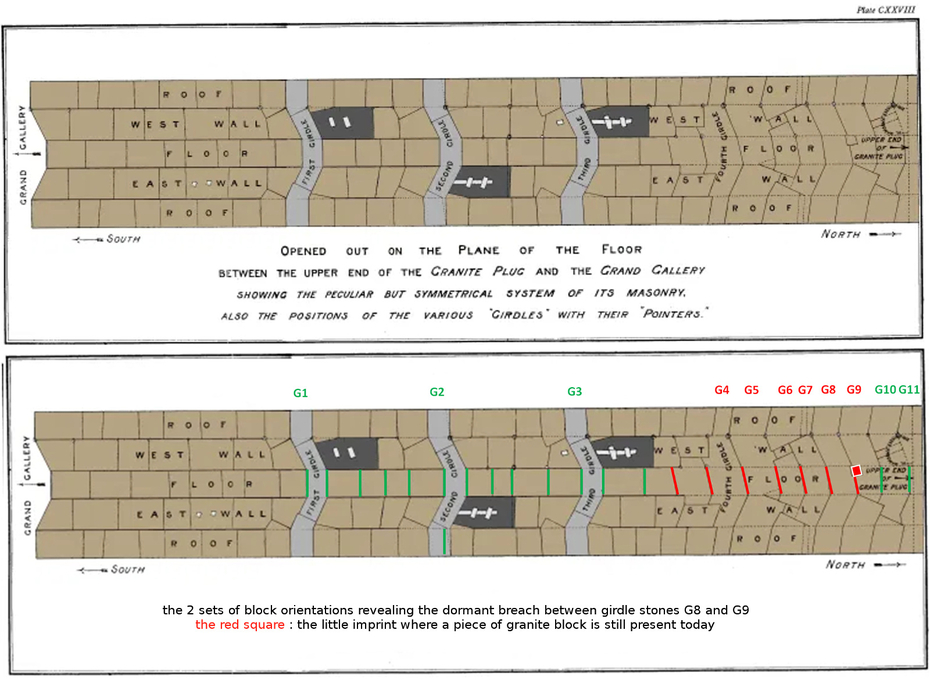
Original of the Diagram of the First Ascending Passage, by John and Morton Edgar, in "Great Pyramid Passages, Volume 1 (1910 edition)", plate CX, paragraph ref. 460, page 230 : https://archive.org/details/GreatPyramidPassagesVol11910Edition/page/n239/mode/2up
7.04 The "bit of granite cemented to the floor" of the ascending passage described by Petrie is Bes
The following excerpt is from "The Pyramids and Temples of Gizeh", by W. M. Flinders Petrie, first published in 1883, page 21 : http://gizamedia.rc.fas.harvard.edu/images/MFA-images/Giza/GizaImage/full/library/petrie_gizeh.pdf
Talking about the Taweret granite block : "The present top one is not the original end ; it is roughly broken, and there is a bit of granite still cemented to the floor some way farther South of it."
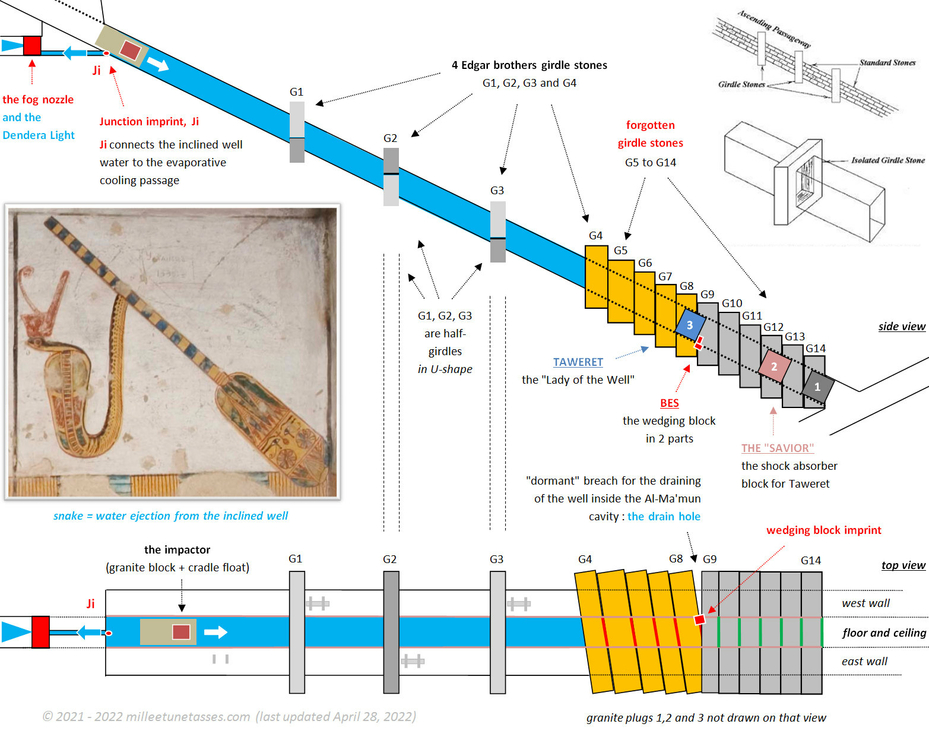
The dormant breach of the inclined well, revealed by the 2 sets of girdle stone orientations.
Photograph from tomb KV 11 of Ramesses III, side chamber, image # 21076 by Matjaz Kacicnik, courtesy of ARCE, American Research Center in Egypt in partnership with the American University in Cairo Egyptology Department : https://thebanmappingproject.com/images/21076jpg
During the entire operating period of the pyramid, the bottom of the inclined well was sealed by the Taweret blog : the upper granite plug. Taweret was maintained in position by a wedging block presenting an easy to break protruding part, getting out of the floor of the well. The breaking of that fragile part released the Taweret block and the waters of the well were drained through the dormant breach, between the Girdle Stones G8 and G9.
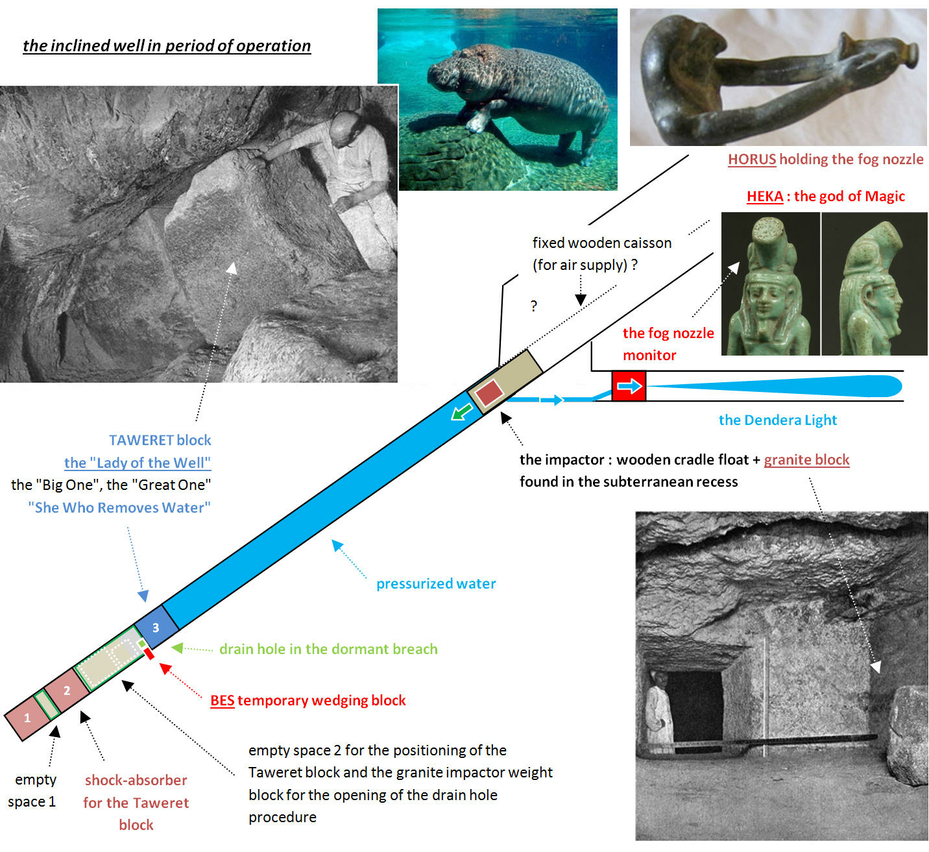
The inclined well of the Great Pyramid of Giza, in operation. Figurine of Heka, the ancient Egyptian god of magic, from the Louvre Museum E 4875 : https://collections.louvre.fr/en/ark:/53355/cl010011666
7.05 The inclined well of the Great Pyramid in operation
The exact position and extent of the drain hole, as well as its real fine opening apparatus are still to be determined.
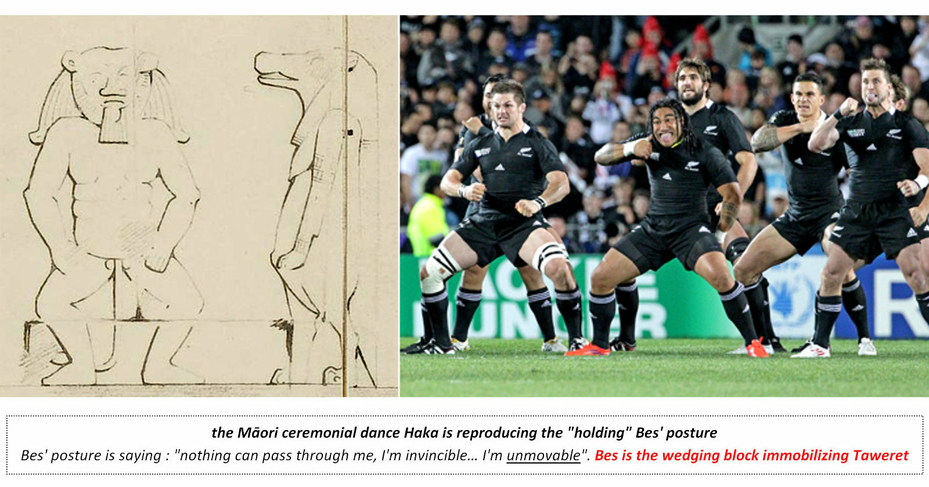
Māori ceremonial dance Haka performers are replicating Bes' posture and gestures : the "I won't move attitude", the "tongue out " and the knife cutting. What Haka performers are saying to their adversaries is : "I'm invincible, I'am unmovable, you'll not pass through me".
Image of the All Blacks, performing the "Kapa o Pango" (a pre-match haka) at the rugby world cup 2011 New Zealand / Argentina, thanks to Jean-Francois Beausejour : https://commons.wikimedia.org/wiki/File:Rugby_world_cup_2011_NEW_ZEALAND_ARGENTINA_(7309674588).jpg
7.06 Bes' posture and the Māori ceremonial dance Haka
This is certainly not by accident that there is a perfect match between Bes's posture and the attitude of rugby players performing the famous Māori ceremonial dance Haka.
Both Bes and the Haka performers are saying the exact same thing : "you will not pass through me, I won't move."
The thing is that the posture similarity is not the only one : even the stories sound familiar.
Ancient Egyptians were engineers, transforming (hot) warm and dry air into cold air. That was the all point of the known part of the Great Pyramid : creating cold air for "sun god Ra".
This is an excerpt from the Wikipedia's page on the Māori ceremonial dance Haka :
"According to Maori scholar Tīmoti Kāretu, the haka has been "erroneously defined by generations of uninformed as 'war dances'", while Māori mythology places haka as a dance "about the celebration of life". Following a creation story, the sun god, Tama-nui-te-rā, had two wives, the Summer Maid, Hine-raumati, and the Winter Maid, Hine-takurua. Haka originated in the coming of Hine-raumati, whose presence on still, hot days was revealed in a quivering appearance in the air. This was the haka of Tāne-rore, the son of Hine-raumati and Tama-nui-te-rā. Hyland comments that "[t]he haka is (and also represents) a natural phenomena [sic]; on hot summer days, the 'shimmering' atmospheric distortion of air emanating from the ground is personified as 'Te Haka a Tānerore'".
https://en.wikipedia.org/wiki/Haka
Of course, even if Māori mythology perfectly borrowed god Bes from ancient Egyptian religion, they also adapted everything around him to create their own mythology.
But still, this is amazing to see they are still referring to a Sun god, including "rā" in his name, or even the idea of hot and cold air (summer and winter). Maybe the reference to a "quivering appearance in the air" is about the creation of the evaporative cold itself...
Also, the Māori name haka itself sounds pretty similar to the ancient Egyptian word for "magic" heka, and the name of the god of magic himself "Heka".
About the Egyptian god Heka : "Heka was the deification of magic and medicine in ancient Egypt. The name is the Egyptian word for "magic". According to Egyptian literature (Coffin text, spell 261), Heka existed "before duality had yet come into being." The term ḥk3w was also used to refer to the practice of magical rituals". https://en.wikipedia.org/wiki/Heka_(god)
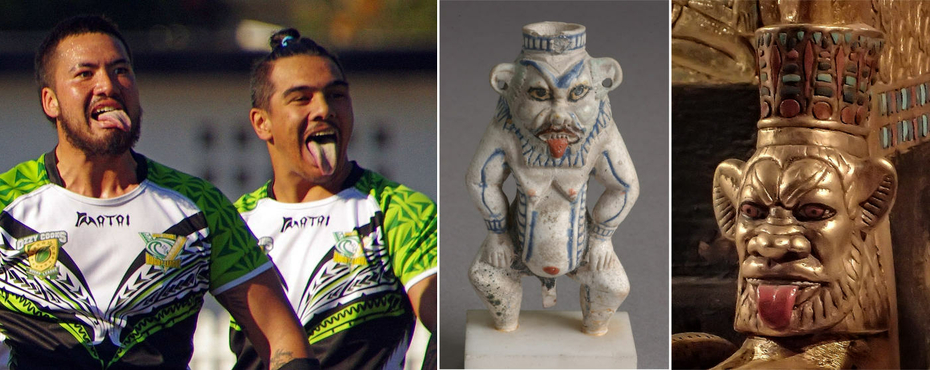
Haka performers replicating the tongue out gesture of the ancient Egyptian Bes deity.
Cook Islands national rugby league team performing it’s war cry, haka, before a test match against Niue in 2015, thanks to Naparazzi : https://fr.wikipedia.org/wiki/Haka
Étui à kohol simple N 4469 from the Louvre Museum : https://collections.louvre.fr/en/ark:/53355/cl010007062
Details of a protective sculpture of the god Bes on one of King Tut's six chariots (18th dynasty, New Kingdom Egypt), photographed by Mary Harrsch at the Discovery of King Tut exhibit at the Oregon Museum of Science and Industry in Portland, Oregon (2016) : https://www.flickr.com/photos/mharrsch/44741722010/in/photostream/
The tongue out and the "throat slitting" gesture in the "Kapa o Pango" Haka
7.07 The tongue out and the spitting water
Not only the Māori ceremonial dance Haka reproduce Bes' posture, but also his tongue out. By doing so, it is obviously a reference to the spitting water that accompany this gesture, and so to the draining of the well.
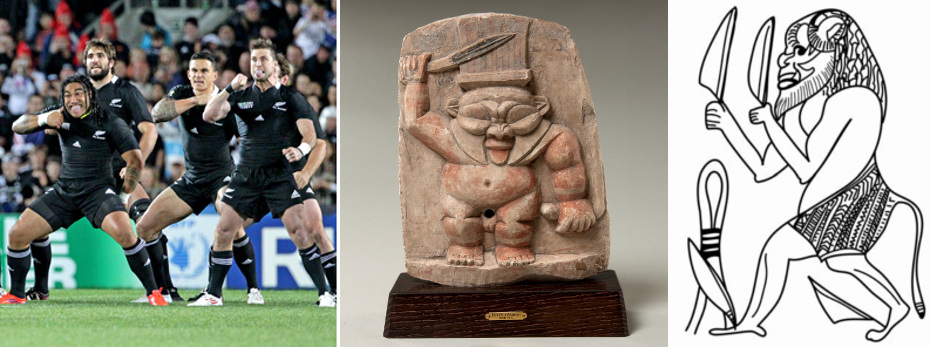
Haka performers replicating the throat slitting gesture of the ancient Egyptian Bes deity.
The "throat slitting" gesture done by the Māori Haka performers, has been completely misunderstood, because it really is a "throat slitting" gesture! But it is absolutely not a provocation towards adversaries : it is a gesture towards themselves.
By "throat slitting" themselves, the Māori Haka performers are only replicating the gesture that Bes is doing by holding his knife over the head, as a metaphor of the breaking off of his upper part. Haka performers are only cutting off their own heads : there is no taunt of any kind towards their competitors in that gesture.
7.08 The "throat slitting" gesture done by Haka performers really is about throat slitting, but it is about themselves
Another strong similarity is the famous "throat slitting" misunderstood gesture that the Haka performers are doing at the very end of the "Kapa o Pango".
"Kapa o Pango" concludes with a gesture which, according to Lardelli, represents "drawing vital energy into the heart and lungs". The gesture has been interpreted as a "throat slitting" gesture that led to accusations that "Kapa o Pango" encourages violence, and sends the wrong message to All Blacks fans." https://en.wikipedia.org/wiki/Kapa_o_Pango
If Lardelli is wrong about his interpretation of the "throat slitting" gesture, nethertheless it is absolutely not a violence reference aimed to Māori competitors. Once again, the Haka performers are reproducing the story of the drainage of the inclined well of the Great Pyramid of Giza : during all the performance they are showing their strength, they are saying that they will not move an inch, that nobody will pass through them, but at the end, they let it go and they are using the exact same knife metaphor that the one used for Bes. Knives and "throat slitting" are metaphors for the breaking off of the wedging block.
Bes, the temporary wedging block was responsible of the draining of the well, he took all the water out of the well and he was worshiped as the god who was responsible of getting all demons out of households.
When Haka performers are "throat slitting" themselves, they are considering their adversaries as demons who should only stay away from their part of the field. That is the real profound meaning of the Haka.
To summarize :
• Haka performers are reproducing the holding posture of Bes : "I'm unmovable, you won't pass through me".
• Haka performers are reproducing the tongue out of Bes : the water reference.
• Haka performers are reproducing the cutting off of their upper part : the release of the Taweret block, the end of the story and the end of the performance.
Don't ask me why and how Māori people did, in some ways, honor and celebrate the ancient Egyptian religion, but the facts are here : the Haka is referring to the Great Pyramid and the draining of its inclined well.
Please note that when represented with 4 knives and the Sa symbol, Bes is not facing frontwards anymore : his holding posture has been broken off by the knives. We'll see farther down this post that the Sa symbol is the representation of the drain hole of the well.
Above Bes-image on the right, from the right panel of triptych on footboard of bed (CG 51109) in KV46. Figure uploaded by Kasia Szpakowska, © Felictas Weber : https://www.researchgate.net/figure/a-Bes-image-from-right-panel-of-triptych-on-footboard-of-bed-CG-51109-in-KV46-b_fig2_312627388
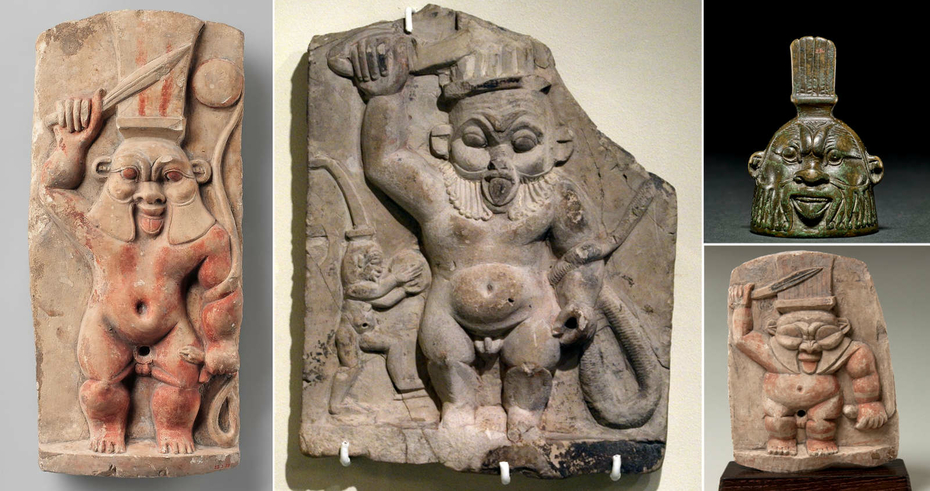
Bes grabbing a snake in his hand and redirecting it towards a hole where his penis should be, is a representation of the draining of the waters of the well through the drain hole.
Stela of the God Bes, 4th century B.C.– A.D. 1st century, from the Metropolitan Museum, New-York : https://www.metmuseum.org/art/collection/search/547866
Dancing Bes and Beset, ca. 664 BCE–ca. 331 BCE, from the Allard Piersonmuseum, Amsterdam and posted on livius : https://www.livius.org/pictures/a/egypt/dancing-bes-and-beset/
Egg-shaped bell EA6374 from the British Museum : https://www.britishmuseum.org/collection/object/Y_EA6374
Relief or Votive Plaque of the God Bes A48 from The Barnes Foundation collection. 664–30 BCE, Limestone with red and black pigment : https://collection.barnesfoundation.org/objects/6670/Relief-or-Votive-Plaque-of-the-God-Bes/
7.09 Bes grabbing the snake in his left (West) hand
In many representations, god Bes is depicted having a firm grasp of a snake, with his left arm. If we look closely to the stela from the MET and the relief from the Barnes Foundation, we can see that the head of the snake is pointed to the same place : a hole where his penis should be.
Because snakes are representations of water, the meaning of this aspect of Bes can be reconstructed : Bes, is catching the water and redirecting it towards the drain hole. And because the left arm is also somehow, the West arm, it also refers to the fact that what I called "the breach" in previous posts, was actually a drain hole located on the West side of the well.
"Bes was a household protector, becoming responsible – throughout ancient Egyptian history – for such varied tasks as killing snakes, fighting off evil spirits, watching after children, and aiding women in labour by fighting off evil spirits, and thus present with Taweret at births."
The draining of the well is the origin of the main metaphor about why Taweret was worshiped as the goddess of childbirth : the water breaking.
7.10 The knife over Bes's head = breaking off the wedging block upper part
We've already seen in the posts about Dendera and Apep, that when ancient Egyptians represented knives in their religious scenes, it wasn't about killing anything or anybody.
Knives mean separate. Here, a better term would be "breaking off". When Bes is holding a knife over his head, it is the representation of the breaking off of the upper part of the wedging block.

Bes Mask from the Walters Art Museum : https://art.thewalters.org/detail/27895/bes-mask-2/
Amulet of the Head of Bes, 664–332 B.C, from the Metropolitan Museum, New-York. Accession Number: 10.130.2057 : https://www.metmuseum.org/art/collection/search/549188
Bes Head Amulet 51.2542 from Museum of Fine Arts, Budapest : https://www.mfab.hu/artworks/bes-head-amulet/
The representations of Bes with his head cut off : as a result of the breaking off of the wedging block upper part, many representations of Bes only show he's upper part : his head.
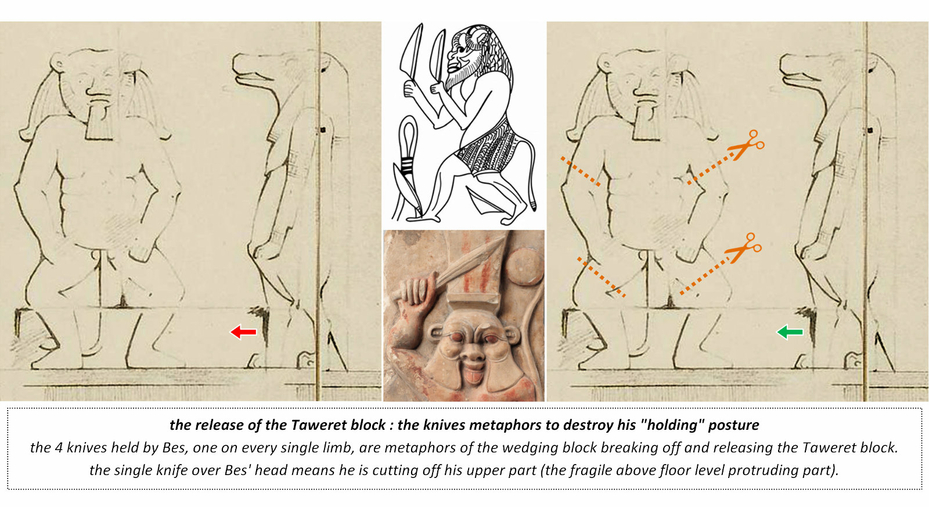
The knifes are metaphors of the breaking off of the Bes wedging block, and the release of the Taweret block. It is a representation of what triggered the draining of the well.
7.11 The breaking off of the wedging block and the release of the Taweret sealing block. Knives = CUT, BREAK
This is breathtaking to think that during the entire operating of the Great Pyramid, the Taweret block was actually only maintained in position by a temporary wedging block (first above image). Its release is what is depicted on the center images.
Like in other occasions, ancient Egyptians used many different ways of depicting this release :
In the lower center image, we have Bes holding the knife over its head to represent the fact that the fragile upper part of the temporary wedging block had to be broken off : the metaphor is directly referring to the original wedging block. In other words, by lifting up the knife over his head, Bes isn't trying to cut the plumes of his headdress, he is just cutting off his upper part.
But on the upper center image, the metaphor is much more elaborate : it’s a metaphor on another metaphor. Bes is the metaphor of the wedging block, and by cutting off every single arm and leg, the other metaphor is that he isn't able to hold Taweret anymore. The most important thing about Bes is his "holding" posture with strong arms and legs, but if you take these elements out of the way, if you cut out his limbs, there is no "holding" posture possible anymore : the Taweret block is then released.
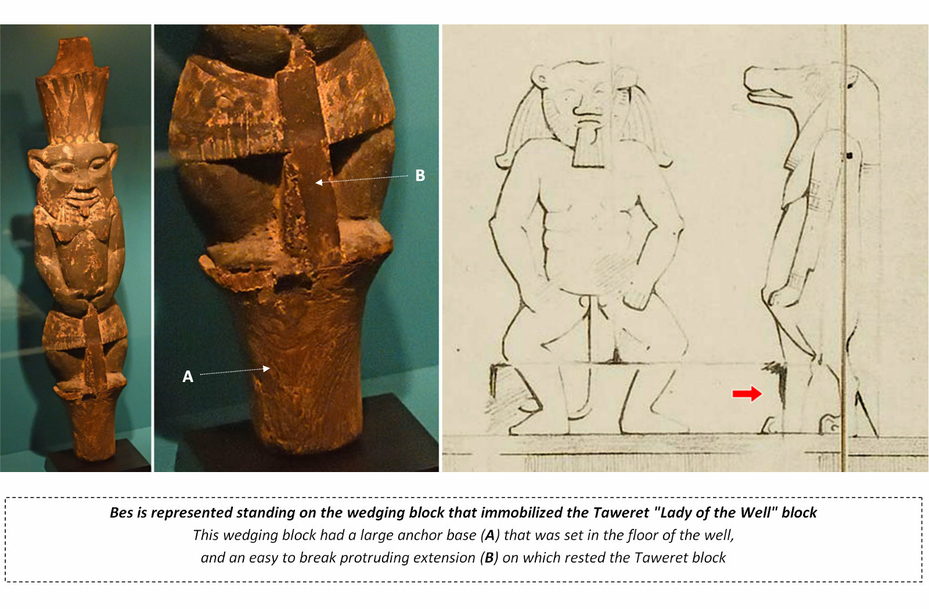
The original design of the Bes wedging block. On this incredible picture, the wedging block is actually represented twice : not only we have the original design of the real block, but we have also its metaphorical representation in the god Bes. Image courtesy of Dosseman, from Two Bes-shaped legs for a bed, wood, New Kingdom : https://commons.wikimedia.org/wiki/File:Allard_Pierson_Museum_Bes_Legs_for_bed_7603.jpg
7.12 The actual original design of the Bes wedging block
More than just being able to validate the couple Taweret/Bes as the 2 blocks sealing the inclined well, we can do even better and have a pretty good idea of the real design of the Bes wedging block, thanks to the "Two Bes-shaped legs for a bed", at the Allard Pierson Museum and Knowledge Institute in Amsterdam, Netherlands.
As I have already said, the simple solution that I came up with, is most certainly wrong or at least incomplete.
The major problem is that the little imprint in the floor of the well between G8 and G9 is located against the West wall. If my idea was correct, this imprint would have been located right in the middle of the width of the well, so that there wouldn't have been any force applied against the wall.
Obviously, something is missing, and the wedging block was only part of the solution, but at least, we can start with something and we now also have what is most probably very close to the real original design of that wedging block : a very large base (A) that would have anchored the block into the floor of the well, and a very fragile protruding upper part (B), that was immobilizing the Taweret block, but which was also ready and easy to break on demand.
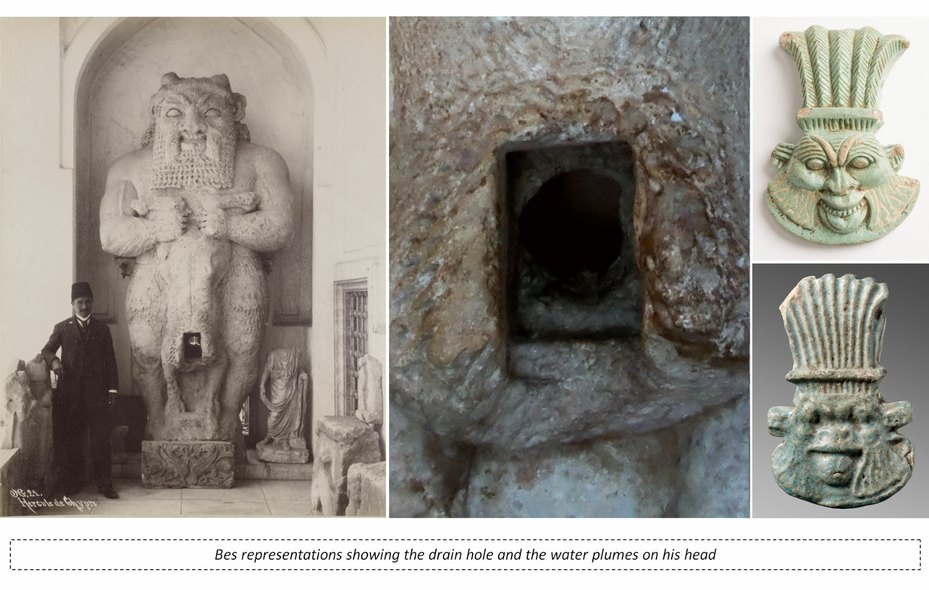
The representation of the drain hole of the inclined well of the Great Pyramid of Giza, on Bes deity.
Detail of Statue of the half-god Bes photographed by Sandstein. Limestone, Amanthus (Cyprus), Roman copy of the Archaic style. Istanbul Archaeological Museums, inv.no. 3317 T : https://commons.wikimedia.org/wiki/File:IAM_3317T_-_Statue_of_Bes.jpg
7.13 The drain hole of the well and the water plumes
We've already seen that the flail was actually made of water, and this is the same thing here with Bes' plumes : they aren't feathers but water plumes, and they are getting out of the drain hole that is often represented onto Bes' head.
On the above photographs, the question is : are we looking at the drain hole from the inside or from the outside of the well ?
Also you'll note on the first photograph, that the hole in Bes' body is entirely passing through the statue.
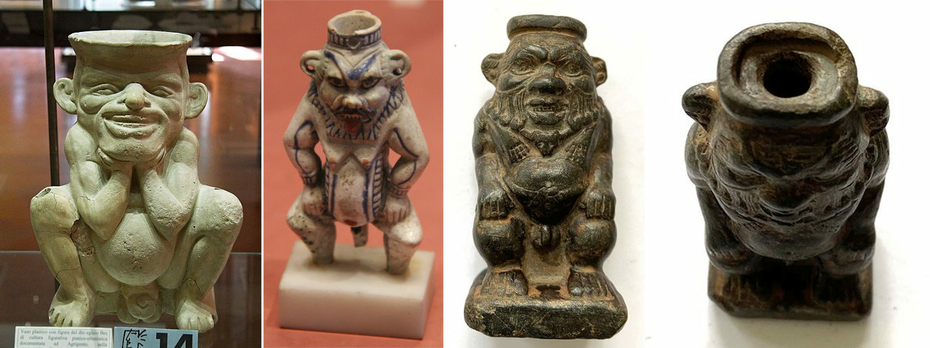
7.14 Bes represented with the drain hole of the inclined well
Vessel modeled in the figure of the Egyptian god Bes. Punic-Hellenistic art in Agrigento. Archaeological Museum of Agrigento thanks to Zde : https://commons.wikimedia.org/wiki/File:Egyptian_god_Bes,_clay_vessel,_Hellenistic,_AM_Agrigento,_120888.jpg
Ancient Egypt Faience Bes photographed by Gary Todd at the Ancient Egypt Gallery, Louvre Museum, Paris : https://www.flickr.com/photos/101561334@N08/28066484040/
Ancient Egyptian Steatite Figure of Bes, God of Merrymaking and Protection, Cosmetic Vessel from catawiki.com : https://www.catawiki.com/en/l/36111955-ancient-egyptian-steatite-figure-of-bes-god-of-merrymaking-and-protection-cosmetic-vessel
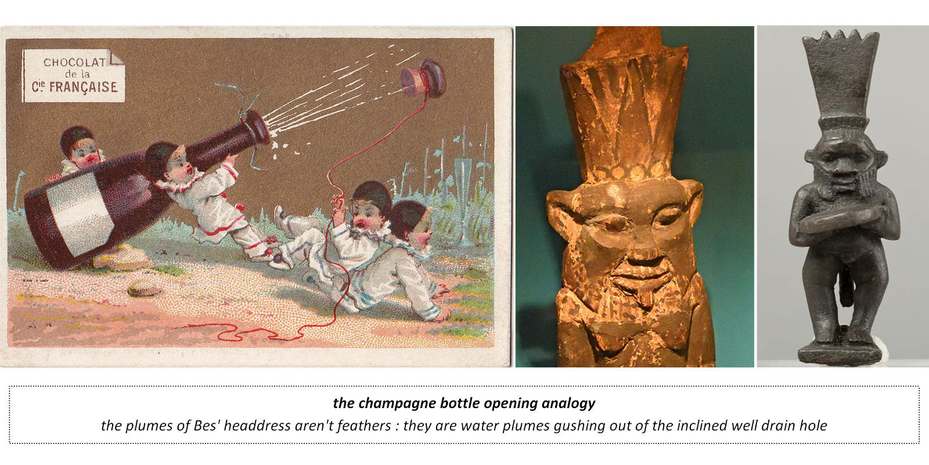
The Bes water plumes as a representation of water gushing out of the drain hole of the well.
Cromo Chocolat de la Compagnie Française, Pierrots opening a giant bottle of chamagne © patrick.marks, posted on flickr : https://www.flickr.com/photos/16691383@N06/49891752078/
Bes with a tambourine from the Metropolitan Museum of Art, New-York. Accession Number: 23.6.16 : https://www.metmuseum.org/art/collection/search/570703

The facetious metaphoric use of the well water draining power by King Tut on his "Ferrari" racing Chariots.
Details of a "protective" sculpture of the god Bes on one of King Tut's six chariots (18th dynasty, New Kingdom Egypt), photographed by Mary Harrsch at the Discovery of King Tut exhibit at the Oregon Museum of Science and Industry in Portland, Oregon (2016) : https://www.flickr.com/photos/mharrsch/33783844026/in/photostream/
Bes figurine thanks to ©JLNicolas from world-in-words.com : https://www.world-in-words.com/news/lilla-del-deu-bes/
Spillway on the Monticello Dam, Lake Berryessa, Napa County California after heavy rains, March 2017, thanks to Phoebe : https://commons.wikimedia.org/wiki/File:Monticello_Dam,_Lake_Berryessa_spillway.jpg
7.15 The facetious metaphoric use of the well water draining power by King Tut on his State Chariots
King Tut died around 18 or 19 years old, and he was not different from kids of the same age today : the same way they are putting hot rod flames stickers on their beloved cars, King Tutankhamun did the exact same thing on his State Chariots.
Except it wasn't flames stickers he put on his chariot, but representations of Bes. Because Bes was a metaphor of the draining of the well, it was associated with the power of the water gushing out of the drain hole.
If protective figures like figureheads on sailing ships are always set at the prow for obvious reasons, the "jet reactor-like" protruding elements under the representations of Bes, are for what it's worth, set at the exact perfect location where a couple of metaphorical pump-jets generating a "magical thrust power out of water" would be installed today : the closest to the axle and the center of gravity of the chariot.
King Tut wanted to get this power for his chariot. So yes, in some way King Tut invented the first metaphorical "pump-jets".
How about that !
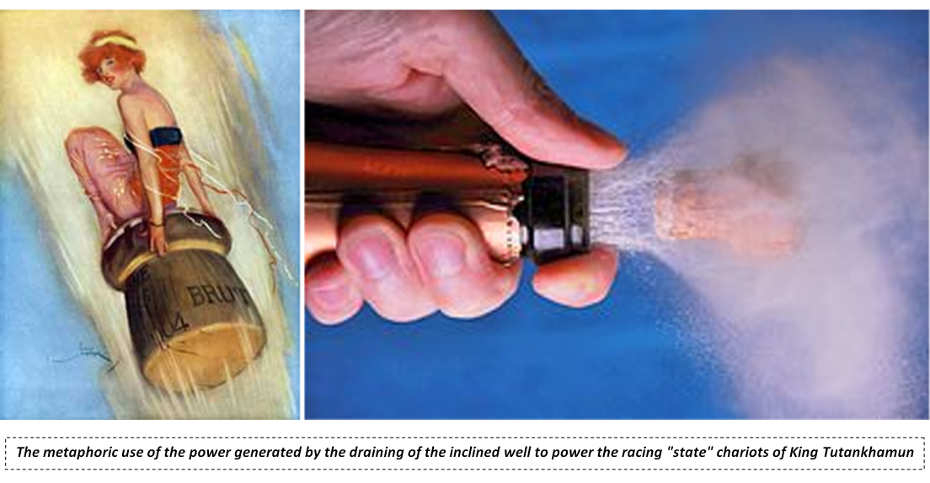
The metaphoric use of the power generated by the draining of the inclined well to power the racing "state" chariots of King Tutankhamun.
Left : 1915 English magazine illustration of a lady riding a Champagne cork (Lordprice Collection) on Wikipedia
Right : Champagne uncorking captured via high-speed photography by Niels Noordhoek

The facetious metaphoric use of the well water draining power by King Tut on his "Ferrari" racing Chariots.
Photograph of a Tut's "State Chariot" at the 2010 Tutankhamun Exhibition in Hamburg, thanks to Hendrik Plank : https://www.flickr.com/photos/7501487@N08/4489917981/
7.16 King Tut's "State" Chariots really were racing Chariots
These excerpts are coming from an article written by Rossella Lorenzi / Discovery Channel and available on nbcnews : https://www.nbcnews.com/id/wbna38545625
"According to Bela Sandor, professor emeritus of engineering physics at University of Wisconsin at Madison, King Tut's chariots surpass all monumental structures of the pharaohs in engineering sophistication."
"There is no evidence of chariot racing from that era, but these chariots have many technical features that imply a pedigree based on racing," Sandor said."
"In a study on the chariots' engineering, Sandor concluded that the vehicles were the earliest high-performance machines, boasting a complex suspension system of springs and shock absorbers. They even featured wheels with aircraft-like damage tolerance."
"They were the Ferrari of antiquity. They boasted an elegant design and an extremely sophisticated and astonishingly modern technology," Alberto Rovetta, professor in robotics engineering at the Polytechnic of Milan, told Discovery News."
King Tut's chariots were all about performance, based on both real and metaphorical technology.
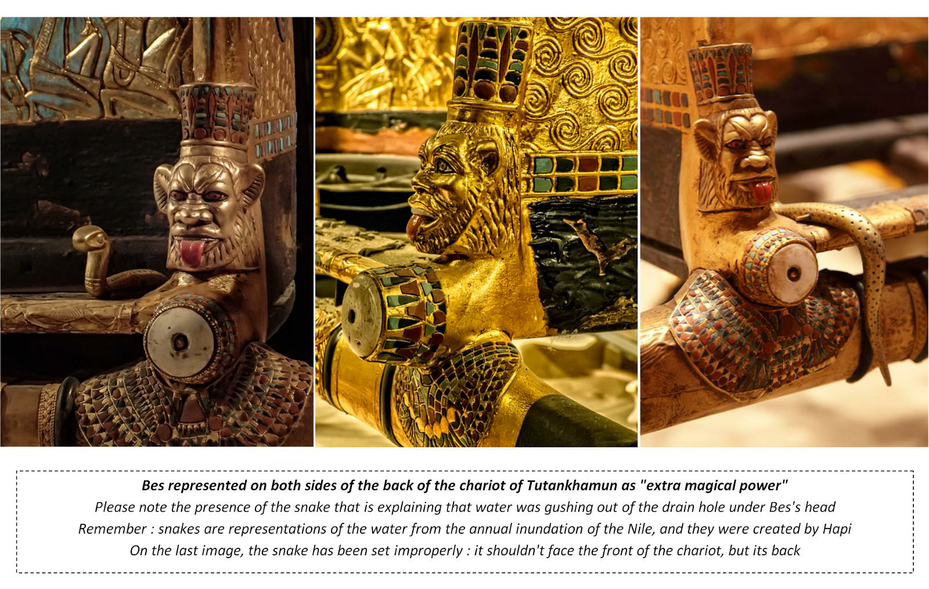
Close-up on the "reactor-like" elements at the back of the racing "State" Chariots of King Tut. They cannot be protective elements, because they would have been set at the front of the Chariots. Against all odds, these elements really are reactors, but it is no air passing through, it is water : these elements, at the back of the Chariots were "metaphorical water jets".
Details of a protective sculpture of the god Bes on one of King Tut's six chariots (18th dynasty, New Kingdom Egypt), photographed by Mary Harrsch at the Discovery of King Tut exhibit at the Oregon Museum of Science and Industry in Portland, Oregon (2016) : https://www.flickr.com/photos/mharrsch/44741722010/in/photostream/ and https://www.flickr.com/photos/mharrsch/33783844026/in/photostream/
Detail of Bes and the drain hole (with the snake in an improperly position, facing front), thanks to ©flydime and posted on flickr : https://www.flickr.com/photos/flydime/3940873078/
7.17 The snakes next to Bes's heads on King Tut's chariots
Just next to the Bes representations on the back of King Tut's chariots, we can see snakes. These snakes are explaining that water was gushing out of Bes's heads. Remember : snakes are representations of the water from the annual inundation of the Nile, and they were created by Hapi.

The archaic look of the Bes deity is referring to the grotto and the Al-Ma'mun cavity of the Great Pyramid of Giza.
Stela for a lion god with Bes and Beset, limestone, Roman Period (NCG 314), photographed by Dosseman : https://commons.wikimedia.org/wiki/File:Allard_Pierson_Museum_Bes_and_Beset_stela_7605.jpg
Cosmetic Container in the Form of a Bes-image, 525–404 B.C. Accession Number: 1989.281.94 from the Metropolitan Museum of Art, New-York : https://www.metmuseum.org/art/collection/search/544908
Soft tissue reconstruction of a Paleolithic hunter (homo sapiens) with a spear-thrower and spear (Cro-Magnom 1, Les Eyzies de Tayac, France). Natural History Museum, Vienna (Austria). Photographed by Wolfgang Sauber : https://fr.vikidia.org/wiki/Homme_de_Cro-Magnon#/media/File:NHM_-_Homo_sapiens_Modell_1a.jpg
7.18 The archaic look and the animal skins
In the above relief showing Bes and Beset, one important thing to note is that both are set inside grottos. These grottos are referring to the grottos of the Great Pyramid : the grotto next to the well-shaft and the cavity supposedly digged by the Caliph Al Mamoun.
These grottos explain why Bes was represented wearing animal hides.
Ancient Egyptians were looking at their ancestors, exactly the same way we do ourselves today : they were imagining them with an archaic kind of "animal" look, wearing animal hides and living into grottos.
Because the draining of the inclined well started and finished into grottos, Bes as a metaphor of that draining was depicted exactly like these ancestors, having a very archaic look and wearing animal skins.
7.19 Bes as a dwarf because of the grotto
We've seen in previous posts that it is in the grotto of the Great Pyramid of Giza (next to the well-shaft), that was initiated and triggered the breach opening and the draining of the inclined well.
For that to happen, someone had to get to the grotto and secure himself from the inevitable part of the water from the King's chamber tank that would find its way to the grotto : both the King's chamber and the inclined well were drained during this unique operation. Most probably, the Davison chamber was as well drained at the same time.
Whoever was the one who accomplished this task from the shelter in the grotto, he (but it could also had been a woman of course), would have been most certainly chosen for his small size.
He could have been a dwarf, but it is also possible that the dwarf reference is only another metaphor for the small size of the person who did the job.
7.20 The Demons and the Party
"He scared away demons from houses, so his statue was put up as a protector. Since he drove off evil, Bes also came to symbolize the good things in life – music, dance, and sexual pleasure." https://en.wikipedia.org/wiki/Bes
One of the most important things about Bes concerns demons and what we could summarize as "partying".
If Bes was "scaring AWAY demons" and "DROVING OFF evil" is clearly referring to the fact that he was actually the one who THREW OUT all the waters of the well, the "partying" thing is completely different in the interpretation.
The draining of the well was the very last stage of the Great Pyramid operating : it was its conclusion. And what do we do today in this situation ?
Yes, we party !
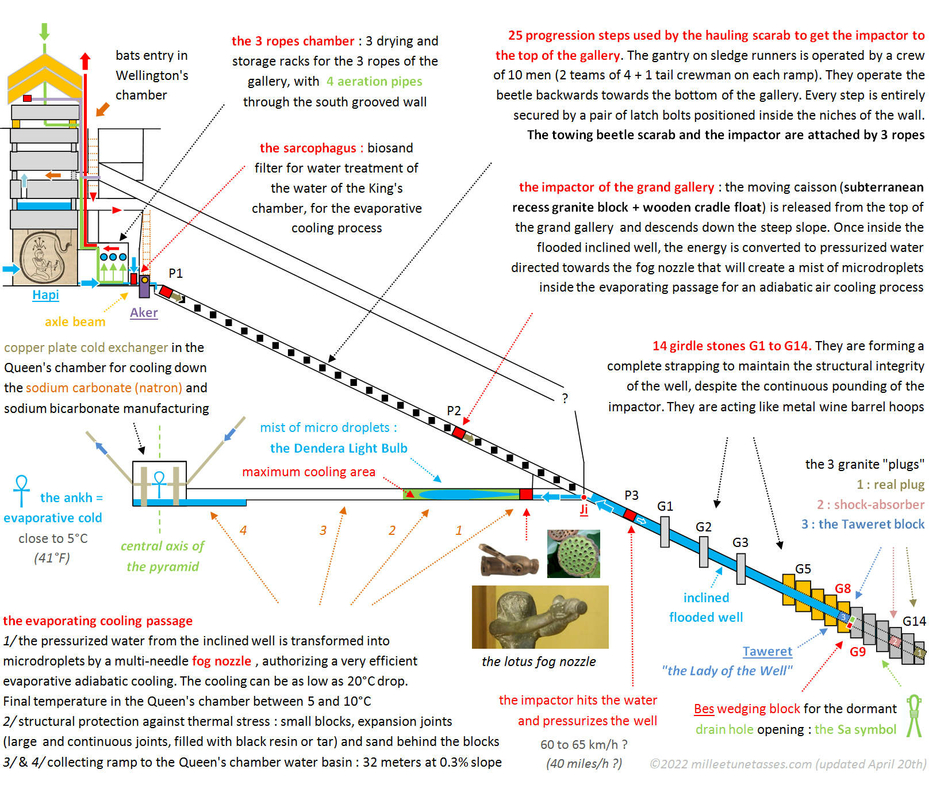
Diagram of the Great Pyramid of Egypt in operation, before the shutdown procedure and the draining of the inclined well.
7.21 Summary of the study : hidden behind the academic vision of the ancient Egyptian religion, a vast number of metaphors are describing some of the most advanced science and technological knowledge of that time : ancient Egyptian gods were nothing else than pharaohs' metaphoric self-glorifications of their theoretical and experimental scientific accomplishments in physics and chemistry.
Pharaohs used the power of Science to legitimate themselves as kings of Egypt : they forged an entire religion, based on science to rule their kingdom, and they presented that science as Magic.
The end game of this technological program that probably started on the very first Dynasty, was the Great Pyramid of Giza where evaporative cooling was engineered in the known part of the pyramid from the pressurized water produced in the inclined well, known today as the ascending passage.
The evaporative cold simply took advantage of the power of water, and was most probably necessary to cool down chemical manufacturing of sodium carbonate and sodium bicarbonate produced by an ammonia-soda Solvay process, as suggested by the very strong ammonia smell and the limestone kiln in the so-called burial chamber of the Red Pyramid. At that time, sodium carbonate was called natron, and it was the salt used for the mummification of the pharaohs (Sections 14, 15 and 16).
The cooling seems to have represented the most difficult part of the process, as suggested by the Step Pyramid's official name : according to scholars, the very first pyramid complex, the Step Pyramid of Djoser, was called "the refreshment of the Gods". No doubt that a more accurate translation would certainly be "the cooling of the Gods".
It means that ancient Egyptians were the first civilization to master a Solvay-like process for sodium carbonate manufacturing, long before it got reinvented in the 1800's in Europe. The key elements of that process is the temperature control of the chemical reactions (the cooling), and the dome shaped plate necessary for the counterflow chemical reactions to occur in an efficient way. That counterflow reaction plate is what really is the disc of Sabu.
As shown with Akhenaten and Nefertiti, the creation of the evaporative cold was the most sacred accomplishment of all (Section 17), and this is exactly what the Dendera Light is all about : the Dendera Light is the fog of microdroplets of liquid water that evaporates and creates the cold. Talking about the snake inside the Dendera Light Bulb : "The field surrounding Ra’s snake form is referred to in ancient Egyptian literature as protective magical energy in liquid form that all gods and pharaohs possess" (Faulkner, Section 2).
Everything that had been done in the Great Pyramid of Giza inspired most of the ancient Egyptian religion, and it had been glorified into what we know today as the Underworld.
The Underworld is referring to the chambers and passages of the Great Pyramid of Khufu, and in particular to the Grand Gallery where a hauling gantry beetle operated a wooden coffin shaped impactor that had a small nested granite block inside it. The impactor generated endlessly, over and over, maybe every 15 minutes the pressurized water that was then transformed into a fog of microdroplets inside the horizontal cooling passage.
The Grand Gallery of the Great Pyramid where the act of hauling was done, is the "Secret Hauling Cavern of the Underworld" described in the Amduat "Book of the Hidden Chamber".
The most important chamber of the Great Pyramid wasn't the King's chamber that only was the main water tank of the pyramid, but the Queen's chamber, the only one on the central axis of the pyramid. Because the Queen's chamber was inaccessible from the rest of the pyramid, it was glorified into the "Hidden Chamber of the Underworld" (Section 11), and because the Queen's chamber was the coolest place in the pyramid (about 5°C / 41°F), and with a constant 100% Humidity rate, this chamber was the one where the biggest amount of very hard salt encrustation had been documented by the first explorers of the pyramid in the 1800's and before it had been removed in 1998 by Zahi Hawass (Section 1). Very hard salt encrustation is the signature of the evaporative cooling process, even nowadays.
The most incredible thing is that pretty much everything I've just said, actually appears in one single myth, but it doesn't originate from ancient Egypt : it is the "Churning of the Ocean" Hindu myth that produces the immortal nectar Amrita. The fact is that the endless churning of water that ends up with the production of an elixir that gives eternal life, is exactly what were doing ancient Egyptians in the inclined well : natron was the salt used for the mummification of pharaohs.
Natron gave eternal life to pharaohs, just like the Amrita (Section 19).
Poster un commentaire

